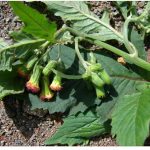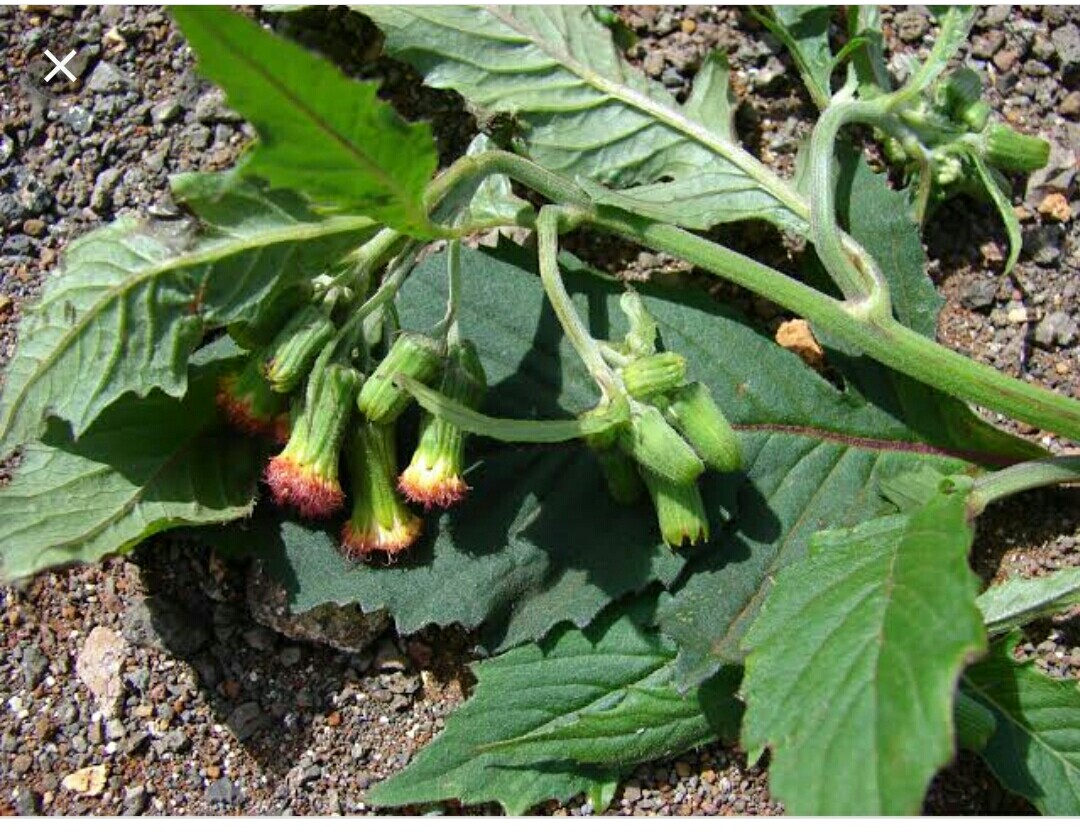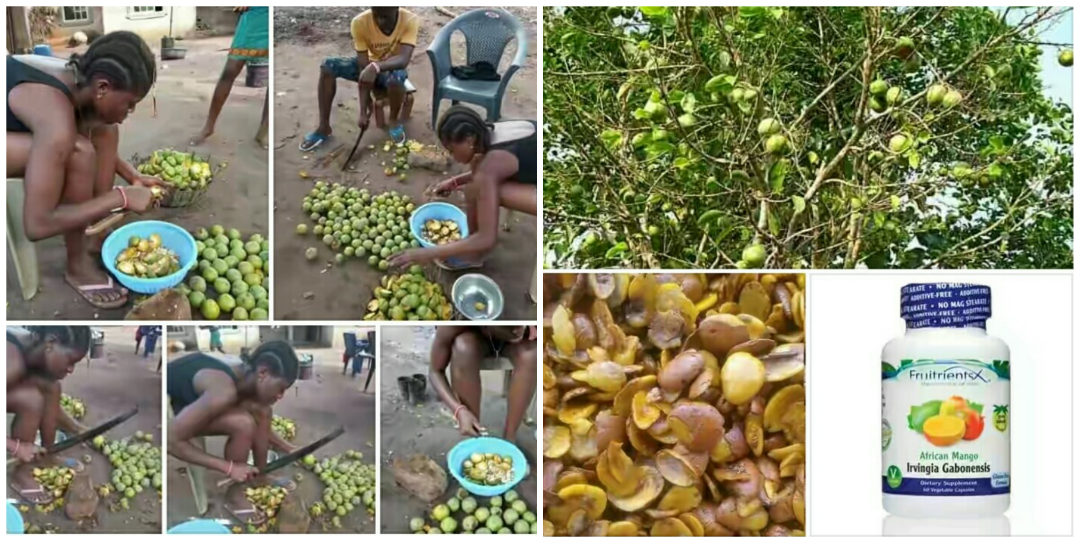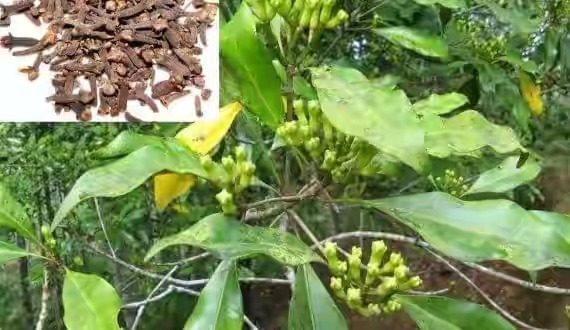Crassocephalum crepidioides (Benth.) S. Moore (synonym: Gynura crepidioides Benth.) or Ebolo, Thickhead, Redflower ragleaf, Fireweed (English) or Babahun, Babaku (Hausa, Ghana) or Babohoh (Hausa, Nigeria) or Alapolo (Igbo) or Ebolo (Yoruba): A green leafy vegetable with medicinal potentials
IDENTIFICATION
A stout erect herb to 1 m high; leaves arranged spirally, flowers are bisexual, equal; corolla tubular, 9-11 mm long, yellow or orange with reddish brown top; fruit a ribbed achene c. 2 mm long, hairy, dark purplish, crowned by white, caducous pappus hairs 9-12 mm long. Seedling with epigeal germination; a weed of cultivation, disturbed land and waste places, occurring across the West African Region from Guinea to W Cameroons and Fernando Po, and generally distributed over tropical Africa. The leafy parts are widely used as a vegetable, e.g. in Sierra Leone, Ghana, Benin, Nigeria, Cameroon, Democratic Republic of Congo and Uganda, and also in Asia. In tropical Africa, Crassocephalum comprises about 24 species, many of which have medicinal uses. The genus is placed in the tribe Senecioneae. Seedlings of Ebolo appear 8-10 days after sowing. Growth of seedlings is fast. Within 40-45 days after sowing the plants are ready for the first harvest by uprooting, and harvesting for seed can start 15-17 weeks after sowing. The wild plant is collected and sold in northern Ghana markets, while in South Nigeria, it is said to be cultivated for sale at Lagos.
IMPORTANCE/HEALTH BENEFITS OF EBOLO
The tender and succulent leaves and stems of Ebolo are mucilaginous and are used as a vegetable in soups and stews, especially in West and Central Africa. It is much appreciated for its special flavour, which is sharp but not bitter. It is especially popular in south-western Nigeria, from where the originally Yoruba name ‘Ebolo’ derives. Here the leaves are lightly blanched, excess water is drained off, and the leaves are then cooked with peppers, onions, tomatoes, melon and sometimes fish or meat to make soups and stews. In Sierra Leone, the leaves are also popular and are made into a sauce with groundnut paste. In Australia, Ebolo is eaten as a salad green, either cooked or raw. The nutritional composition of Ebolo leaves per 100 g edible portion is: water 79.9%, energy 64 kcal, protein 3.2 g, fat 0.7 g, carbohydrate 14.0 g, fibre 1.9 g, Ca 260 mg and P 52 mg. The leaves are mildly stomachic. In southern Nigeria, the leaves of Ebolo are used to treat indigestion and in Congo the leaf-sap is taken for upset tummy with colic and flatulence.
The leaves prepared as a lotion or a decoction are also used in Nigeria as an analgesic for headache. In the Democratic Republic of Congo, leaf sap is given to treat upset stomach, in Uganda it is used as a treatment for fresh wounds. A leaf lotion or decoction is used to treat headache in Nigeria, and in Tanzania a mixture of the leaf sap of Crassocephalum crepidioides and Cymbopogon giganteus Chiov. (Gamba, Kyara, Hausa) is used orally and externally for the treatment of epilepsy.

In Tanzania, the dried leaf powder is applied as a snuff to stop nose bleeding and smoked to treat sleeping sickness. Tannin found in the roots of the plant is used to treat swollen lips. The plants are readily eaten by livestock and they are considered a useful green fodder for poultry. Crassocephalum crepidioides has been used successfully as a trap plant to collect adult corm weevils in banana plantations.
FUTURE
Crassocephalum crepidioides is an easy to grow vegetable, especially suited to shady localities in home gardens and tree plantations. Breeding of improved cultivars is needed, as well as research to solve the problem of seed availability that has hitherto limited cultivation. Research on its safe use as a vegetable is desirable since the presence of pyrrolizidine alkaloids, which are hepatotoxic or even carcinogenic, has been reported for Asian plants.
MAJOR REFERENCES: Journal of Chemical and Pharmaceutical Research, 2013, 5(6):160-167; Pakistan Journal of Nutrition (2007); 6: (1) 35-39.
These are the thoughts of:
Sa’eed Halilu Bawa
Senior Lecturer (Associate Professor) at University of the West Indies, St. Augustine Campus, Trinidad.
Studied Food and Nutrition Sciences, Dietetics at Kaduna Polytechnic, Nigeria; Warsaw University of Life Sciences, Poland.

























How does it smell.. Did the Yoruba proverb mean it smells like the field or actual faeces?
Does not smell like faeces.
Your question suggests to me that you do not understand the different and actual meaning of the word ”igbe’, especially ‘ from the proverb associated with Ebolo vegetable. ‘Igbe’ means bush in the context of the proverb and not faeces as you and many half backed Yoruba speaker erroneously implied.
Ebolo is a rare, scarce and delightful vegetable, usually meant for people who can afford it in volume. It’s so delight-able to cook for its super AROMA and taste, expensive than other vegetables and not easily available on the market compared to the likes of Tete, Shoko, Ewedu etc.
Ebolo’s strong aroma leads to the Yoruba proverb which can be interpreted as ‘no matter how much you cook ebolo, its BUSH given aroma will not dispense’. Note the word BUSH not FAECES. I hope this helps.
Cheers
Oyebode has done great justice to the subject on how Yoruba people, uses the word Igbe to lay emphasis on how difficult it is to access the ebolo vegetable. Which makes it a delicacy for the rich.